“Bucket!” a deep, Creole-inflected voice sang up to me. “BucketBucketBucket!”

From where I stood, partway up a steep, crumbling dirt hillside on the south coast of Haiti, the owner of the voice was invisible. But then Ernst, a tall young man with bare shoulders like gleaming obsidian, rounded a stand of boulders just below me. From his hands swung two plastic five-gallon buckets, each heavy with rocks. Grinning, he thrust the buckets up toward me; I took them, staggering a little from their weight. Luckily, I had to lurch only about a dozen steps up the hill before handing them off to the next person on line.
It was the fourth day I’d spent on the hillside, in the small village of Cyvadier overlooking the sapphire-blue Bay of Jacmel. Each morning, before the late-July temperatures climbed above 100 degrees, some 25 locals and visiting American volunteers gathered at the base of this 400-foot slope. There sat a giant heap of rocks, next to a dirt trail that snaked up between slabs of porous stone, flowering shrubs, munching goats, and yellow butterflies. Our task was simple, and Sisyphean: move the rocks from the bottom of the hill to the top.
At the summit, a local community-building organization called Let Haiti Live had its headquarters. The compound consisted of two cement buildings—where dozens of village children attended classes in agronomy and environmental conservation—and a small lean-to where cooks prepared meals for the kids over an open charcoal fire. Our pile of rocks would form the walls of a new kitchen—one that could feed more kids, more ecologically and safely.
A backhoe could have done the job in an hour, if there had been a backhoe—and a road for it to drive on, and cash to pay the driver. But since there were none of those things, we had strung ourselves each day along the trail and, sweating through our clothes in the punishing heat, passed the load bit by bit, like an old-time fire brigade putting out a blaze.
The project, in the scope of things, was tiny; the effort required to achieve it, huge. But this, it seemed, was the way that things got done in Haiti: the hard way.
***
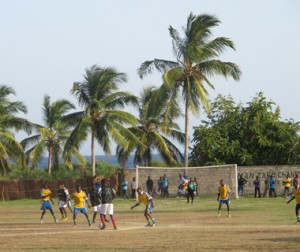 None of my friends could imagine actually wanting to go to Haiti. All most of them knew of the country was what they’d read about in headlines: the 2010 earthquake that had killed some 100,000 residents and devastated millions of homes; the cholera epidemic that had subsequently swept through the population; the decades of political corruption and economic hardship that had relegated Haiti to its standing as the poorest country in the Western Hemisphere. People like me, it seemed, went to Haiti not out of interest but out of a sense of obligation—to join the ranks of the estimated 10,000 relief organizations operating on the ground there.
None of my friends could imagine actually wanting to go to Haiti. All most of them knew of the country was what they’d read about in headlines: the 2010 earthquake that had killed some 100,000 residents and devastated millions of homes; the cholera epidemic that had subsequently swept through the population; the decades of political corruption and economic hardship that had relegated Haiti to its standing as the poorest country in the Western Hemisphere. People like me, it seemed, went to Haiti not out of interest but out of a sense of obligation—to join the ranks of the estimated 10,000 relief organizations operating on the ground there.
But I’d heard other stories about the country too—ones that had piqued my curiosity as well as my desire to lend a hand. Haiti had dazzling and unspoiled landscapes, sweeping beaches, and verdant mountains that had given it the nickname “The Pearl of the Antilles” during its heyday in the pre-Duvalier 1950s. And the island’s distinctive cultural traditions—art, music, cuisine, and voodoo-infused spiritualism—made it unique among Caribbean nations.
I’d learned about these draws through a somewhat surprising recent campaign to brand Haiti as a vacation destination. Haiti’s Ministry of Tourism has thus far allotted some $450 million to this effort, and launched a splashy new logo and slogan inviting visitors to “Experience It!”—promoted, of course, on its new Twitter feed and Facebook page.
But the tourism push isn’t just internal. Several major chain hotels, including a Marriott, an Occidental, and a Best Western, have plans to create some 2,000 new hotel rooms in Haiti in the coming year. A small herd of A-listers, including Bill Clinton and Donna Karan, have been devoting time and money to promote Haiti as a hub of cultural riches. And in November, British imprint Bradt Travel Guides plans to release the only English-language Haiti guidebook to publish since the 1980s. According to Bradt’s publishing director, Adrian Phillips, “tourism has a key role in the process of rebuilding Haiti…our hope is that this guide will play its part.”
How, I wondered, did these radically different ideas of Haiti jibe? Could the country really support an influx of foreign travelers when, almost two years after its disastrous earthquake, 500,000 residents were still living in tent cities?
Exploring this question, I knew, would require traveling to Haiti myself. And since I was both unfamiliar with the Creole language and wary of traveling alone in a developing country, it made sense to go with a group. But choosing the right outfit was a dizzying proposition. The profusion of volunteer-assisted development organizations operating in Haiti—ranging from church mission groups to grassroots art collectives to renowned multinational corporations like Partners In Health—had prompted the American media to coin a nickname for the country after the earthquake: “the Republic of NGOs.” And, in a sign that Haiti is already moving toward commercial tourism, there were newer travel opportunities too—ones with more of an educational focus, like nature photography, yoga workshops, and art festivals.
One option I didn’t have: mainstream tour companies, which aren’t offering itineraries yet. But since there was so much rebuilding to do, it seemed the best interim step for experiencing the country was through voluntourism. So I chose a nine-day trip with a small Boston-based tour operator, Elevate Destinations, which combined volunteer work (with Let Haiti Live) and trips to some of Haiti’s most famous attractions (Jacmel’s art galleries, southern-coast beaches, waterfall-fed forest pools). I especially liked that Elevate Destinations required trip participants to spend several weeks fund-raising before the trip; that meant that the money we raised (about $10,000) would cover all the building and educational materials we’d be using, as well as our own food and transport. No one in Haiti, in other words, would have to put themselves out for us.
***
My flight to Port-au-Prince, only three and a half hours direct from New York, was a cinch. Things got rougher when our group of 13 piled into two battered vans for the three-hour ride to Cyvadier. After juddering along the rutted city roads, which led through garbage-heaped slums and tent cities outside Port-au-Prince, our drivers headed south across a mountain range riddled with freakily skewed hairpin turns. Still, the route looked out over beautiful scenery—terraced valleys, swales of shade trees, a hazy scrim of blue ocean—which I appreciated as best I could between bouts of nausea.

Most of my travel companions were, like me, first-time visitors to Haiti; many were also serial do-gooders, who’d put in time volunteering for causes and organizations around the globe. Our two trip leaders, Andrew and Meryl (who worked day jobs as, respectively, a journalist covering responsible tourism and a lawyer for various nonprofits), told us about the Let Haiti Live compound—the dozens of children we’d meet there, the warmth of the staffers, the delicious porridge and cabri en sauce (stewed goat) cooked over open fires.
The vans dropped us at the base of the same hill we’d soon be climbing with our buckets of rocks. But for our inaugural walk up the slope, all we carried was our own luggage. After ducking beneath a handmade archway that local residents had fashioned from bent sticks and flowers (on the dirt next to it, “Welcome” was spelled out in small white stones), we were warmly received by the three full-time Let Haiti Live staffers—reforestation expert Guerlyne, agronomist Cheler, and community developer Elie. A group of children had trailed us up the hill, and one, a shy four-year-old girl with beaded braids named Lunja, suddenly recognized Meryl from the previous summer’s trip and leaped into her arms.
The majority of our group would be setting up tents here. But once I’d scoped out the rock-strewn terrain (which we later learned was crawling with biting ants and tarantulas), and the single bathroom without running water, I felt glad that with a handful of others I’d decided to stay in a hotel down the street that catered to foreign relief workers. It was a little rough around the edges, but infinitely better than shacking up with dinner roll–size spiders.
***
We spent each morning over the next week hauling rocks up the hillside for Let Haiti Live’s new kitchen—and after just a few days we could see staffers mixing the cement and starting to lay the walls. The kids who came to the compound every day for lunch and classes were eager to pitch in; many mornings when we showed up for the bucket line, eight or nine teenage boys had arrived earlier than us and had already started shoveling and carrying rocks on their own. Those who were too small to help would keep us company, or run to fill our water bottles with dlo—the Creole adaptation of “de l’eau.”
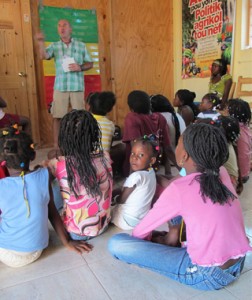
In the afternoons, we led classes for these same kids, about 40 of whom came to the compound for daily “summer camp” and hot meals. With the help of Creole translators, we each took turns teaching some subject in which we had expertise. Some of the sessions turned out to be great fun; a yoga class led by a group member named Nancy, for example, turned into a squealing giggle-fest as the young kids yelled out the names for each pose: “Tree!” “Frog!” Others, like the basic first-aid class run by a medical student named Stephanie, were met with rapt attention and energetic discussion (Do you cover a burn or leave it open to the air? What about a dog bite?).
Regardless of the subject matter, I was touched by the seriousness that many of the children brought to the classes. While some kids took part in a now nearly universal distraction—texting on their cell phones—I saw others taking careful notes in their composition books, or seeking us out after class to ask questions in halting English.
The spirit of earnest enthusiasm seemed to permeate all the endeavors at Let Haiti Live. We saw some of these, like the large nursery to grow crops for the community and educational programs in reforestation and conservation (Haiti’s forests have been decimated by the perpetual need for charcoal, the only cooking and heating fuel most residents have). But it was clear these efforts made a strong impression on the kids. Many of them said they wanted to be agronomists when they grew up; and more than once, as I was walking through the compound, a child would steer me away from stepping on a plant that had been intentionally cultivated.
The kids joined us on many of our after-class outings as well. One afternoon, we all loaded into a tap tap (a brightly painted local bus) and rode to see a local soccer game. Another evening, we went to see a band playcompas (a percussive style of dance music unique to Haiti) at a neighborhood bar—and ended the night crowding a tiny dance floor with students and staffers from Let Haiti Live. A few days later, we took a field trip to a palm-shaded local beach, where the children danced for us, trounced us at soccer, and—despite lacking both swimming ability and bathing suits—jumped, fully clothed, into the surf with us.
***
The nearby historic port town of Jacmel left a markedly different impression on me. Jacmel has for decades been celebrated as the country’s artistic heart; its streets, where the crumbling-but-genteel architecture evokes the French Quarter of New Orleans, are lined with galleries and art studios. On the day we visited, the electricity was out in much of the city, but we could still peruse exhibits of paintings, which looked remarkable even in the near-dark.
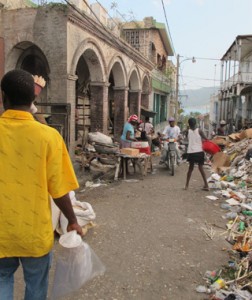
For Haiti’s Ministry of Tourism, as well as several developers and tour companies, Jacmel has occupied a particular spotlight in recent years. The outpouring of creativity has the potential to lure culture-minded travelers, and it’s here that the artistic community hosts annual film and music festivals, voodoo ceremonies, and one of the Caribbean’s biggest Carnival celebrations. Drawing attention to these attractions, the ministry hopes, will help boost the number of annual visitors to Haiti (just 300,000 in 2011) closer to that of the neighboring Dominican Republic (4.3 million).
But even this promising city didn’t seem quite ready for wholesale tourism. As we walked through town and down toward shore, we saw streets still lined in rubble from the 2010 earthquake. Ringing the open-air Iron Market—where vendors sold everything from used shoes to produce—were heaps of stinking trash (Haiti has no official garbage-disposal system, so what doesn’t get burned simply piles up). Stray dogs, rib cages showing through their mangy fur, were everywhere.
Still, once at the beach, we found a great seafood shack, where we lounged around brightly painted tables and feasted on platters of aromatic lobster Creole and whole roasted fish. Partway through our meal, though—when night had fallen and we had all drunk many bottles of Prestige, the local beer—one volunteer, Kara, suddenly spun in her seat, as though searching for something behind her. Over the next few minutes, she did the same thing twice more.
“What is it?” Andrew asked, noticing her discomfort.
“There’s a boy,” Kara said quietly. “A young boy, sitting back there. He’s pitching rocks at me.”
At first I misunderstood. I imagined that the boy felt indignant, offended enough by our presence to want to chase us away. But then Kara clarified.
“He’s not throwing them hard,” she said. “I think he’s just letting me know he’s there. I think he’s just hungry.”
***
Those who hope to drive tourists to Jacmel, and to Haiti in general, are well aware of the inherent obstacles. Haiti’s Tourism Minister, Stephanie Villedrouin, spent a good part of the past summer on a speaking tour to rally foreign investors; the funds she hopes to drum up would go a long way toward helping the country build some of the infrastructure it needs to support international travelers. Among the proposed projects are an expansion of Jacmel’s tiny airport to accommodate flights from the U.S., and new roads that would allow access from Jacmel to other south-coast attractions—like the gorgeous white-sand beaches of Port Salut and Les Cayes, which rival those in the Exumas and Turks and Caicos.
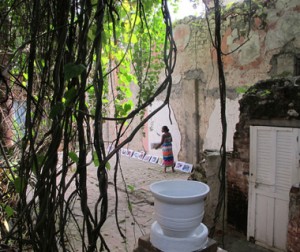
As well as laying a foundation for new tourism, such elementary resources would allow at least one high-profile but half-finished development project in Jacmel to be completed. For the past two years, Michael Capponi, a Miami-based construction magnate and nightclub promoter, has spent significant time and effort to convert a 200-year-old coffee-sorting house near Jacmel’s port into a boutique resort. Le Village de Port-Jacmel, as Capponi envisions it, will include shops, restaurants, galleries, and bars, as well as accommodations; once finished, Capponi says, the complex could “lay the tracks for tourism in Jacmel.”
But the project is currently sitting only partly completed, as it has for several months. The reason is simple: lack of funds. “Investors are nervous,” Capponi says. “They see Haiti as high risk. So it’s a struggle getting funding, at least now when those basic elements [an airport, roads] aren’t in place. I mean, it’s not going to be St. Barth’s anytime soon.”
But while it may take time for travelers to see Haiti as a glamorous beach destination, some promoters are trying a different tactic—using the country’s undeveloped environment as a selling point. Extreme-sports enthusiasts, in particular—mountain bikers and ultra-marathoners—are being lured by the debut of major race events in the coming year.
According to Paul Clammer, author of the soon-to-be-released Bradt’s Travel Guide to Haiti, there are also plenty of garden-variety adventurers who are attracted, rather than discouraged, by the very grittiness of the travel experience in Haiti.
“If you think back, there’s a long tradition of travelers seeking out destinations that are off the beaten path,” Clammer says. “A few decades ago, places like Peru and Nepal were really untrammeled…they didn’t have anything like the infrastructure they have now. But people still went there; that was part of the draw. So Haiti is already ready for visitors—certain kinds of visitors.”
While Clammer says it makes sense that foreigners—especially North Americans, who are practically next door—will want to continue helping Haiti, it also makes sense to expand the boundaries of what we think of as “help.”
“Sometimes just going out and spending your money at a local bar or restaurant is what makes a difference,” Clammer says. “Personally, I’d love to see people go to Haiti just for a vacation. Haiti isn’t a project—it’s a country, and even though it’s a poor country, it’s also gorgeous.
“It seems somewhat radical to think of it as just another travel destination,” Clammer says, “but I believe it can be.”
***
I got to share in that vision—Haiti as vacation spot—on one of the last outings we took on our trip. We boarded our vans that day and drove north from Cyvadier into a range of thickly forested mountains. After parking at the entrance to a slippery uphill hiking trail, we all climbed, accompanied by guides who helped us cross rushing streams and scramble over moss-covered boulders. Eventually, we emerged into a high clearing, where we were greeted by a breathtaking sight: three glittering, cyan-blue freshwater pools surrounded by rocky cliffs and fed by a thundering waterfall.
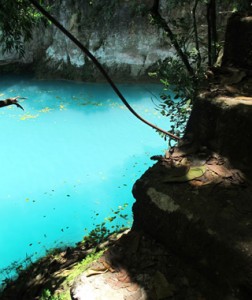
The Bassins Bleu are some of Haiti’s most prized natural treasures. And we certainly weren’t the only ones who had come to enjoy them; everywhere, groups of Haitian teenagers and foreign travelers were floating in the clear, cold water; sunning on the rocks; and jumping off outcroppings above the pools. It wasn’t exactly peaceful—not with all the splashing and shrieking—but I felt a deep sense of calm there, of almost beatific serenity.
For a while I treaded water alone under the churning waterfall, watching friends and strangers cavort around me. And then suddenly I realized why I felt so happy. It wasn’t just that the pools were arrestingly beautiful. It was that I didn’t feel like a stranger here, like some sort of outside intruder. The week of working at Let Haiti Live, and being part of its community, had allowed me to feel like this was—if only a tiny bit, and only temporarily—my place, too.
***
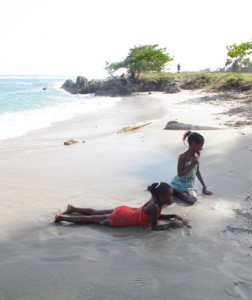
Voluntourism Programs in Haiti
While there are thousands of opportunities for doing unadulterated volunteer work in Haiti, a few programs have distinguished themselves by adopting a voluntourism-type business model. These programs augment their work on community-building projects with visits to some of the country’s natural and cultural treasures.
Elevate Destinations runs trips based in Cyvadier, a village just outside the south-coast city of Jacmel. Its volunteer projects, which include construction, agronomy, and workshops with local children, are done in partnership with the organization Let Haiti Live. Trip participants also make visits to beaches, waterfalls, and art galleries in Jacmel and Port-au-Prince. elevatedestinations.com; lethaitilive.org
The Village Experience offers trips to Haiti’s northern coast. Participants make their home base in the city of Cap-Haïtien, from which they travel to several of the area’s UNESCO World Heritage sites and beaches. They also take part in community outreach projects—including literacy, education, and economic development—in conjunction with Haitian organization Sonjé Ayiti. experiencethevillage.com;sonjeayiti.com
Yoga Ventures runs weeklong trips to Jacmel that incorporate daily yoga and meditation sessions; trips to local museums, galleries, festivals, and cooking classes; and volunteer projects with several local organizations, including the Jacmel Children’s Center and Angel Wings International. yogaventures.org; jacmelchildren.org;angelwingsinternational.org
Mountain Bike Ayiti is introducing the first part of what will eventually be an 80-mile multistage race between Port-au-Prince and Jacmel in January 2013. Not only will participants get to compete on challenging terrain against bikers from around the world, they’ll also work to clear and improve trails for subsequent races (thus helping to bring more long-term adventure events to the country). mtbayiti.org
For runners who want to contribute by supporting Haiti’s new focus on extreme sports, Run Haiti is holding its second annual 60-mile race, which will bring runners from Port-au-Prince to Jacmel; February 7–9, 2013.runhaiti.com


